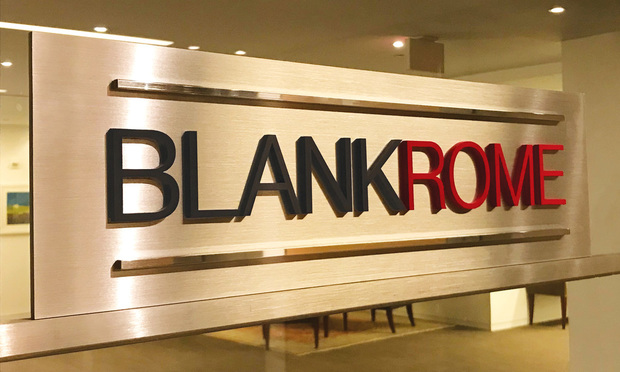How Blank Rome Went From Representing Insurers to Suing Them
Two years after making a big bet to switch sides, the firm's gamble appears to be paying off.
July 04, 2018 at 04:49 PM
9 minute read

When the remains of Dickstein Shapiro went shopping for a new home in early 2016, most potential suitors saw the firm's insurance recovery practice as a conflict-ridden complication—a deal breaker. For Blank Rome, it was an opportunity, albeit one that forced some tough decisions.
By February 2016, Philadelphia-based Blank Rome decided to make the deal, adding the insurance practice and about 80 other lawyers from Dickstein Shapiro. Two-and-a-half years later, the practice has grown through some key lateral hires, and has successfully cross-sold to dozens of legacy Blank Rome clients. But that meant cutting ties with at least one major insurer client.
Practice group leader James Murray says he knew from the start that success would require swift rebranding action and a commitment from Blank Rome to keeping insurance company clients off the firm's roster.
While other large firms have moved out of the insurance recovery space, Blank Rome leadership says it's there to stay.
Remaining Relevant
In 2015, Dickstein Shapiro's lawyers realized they would have to become part of another law firm. But many of the potential acquirers either had an existing practice representing insurers or were heavily into panels, Murray says. It was difficult to find a large, full-service firm where the practice group of about 20 lawyers would be able to remain conflict-free.
“There were some discussions with firms where we were absolutely out,” Murray says.
Then Blank Rome came along.
At the time, Blank Rome didn't have an insurance practice—recovery or defense—but the partners talked about it internally often, Blank Rome chairman Alan Hoffman says.
“From time to time an insurance recovery lateral would arise,” he says, but the firm didn't want to bring on a single partner without support.
When the firm saw the opportunity to add Dickstein Shapiro's remaining lawyers, Hoffman says, keeping the insurance recovery practice seemed like “a great way to remain relevant” to the firm's corporate clients. Since Blank Rome already represented them in other business matters, he says, why not add insurance recovery to that list?
And Murray learned that his whole group would be welcome.
In February 2016, the Philadelphia-based Am Law 100 firm absorbed more than 100 lawyers from foundering Dickstein Shapiro—not in a merger; the latter ceased practicing law.
Going Conflict-Free
Adding an insurance recovery practice called for a few sacrifices and some quickly executed branding.
First, Blank Rome had to commit to giving up any conflicting work. The firm had been involved in panels for Chubb and AIG, working on their insureds' labor and employment matters. The Chubb panels had to go entirely, Hoffman says. Blank Rome was able to stay on AIG's panels, but gave up the work in New Jersey and California, where firms are prohibited from working on an insurer's panel, then later suing that insurer for recovery.
“One of the most important—but one of the most difficult—things about strategy is to say no” to some opportunities in order to seize upon others, says Marci Taylor, law firm consultant and founder of Mantra Partner. “Doing that—and sticking to it—is impressive.”
Hoffman says losing the panel work didn't have a significant impact on the labor and employment practice or cause any layoffs. The impact on the firm was far outweighed by the potential insurance recovery revenue.
Meanwhile, Murray says, it was imperative that his group make it known to clients—and the rest of the insurance recovery bar—that their joining Blank Rome would not create conflicts.
“If [competitors] even sniff that you represent an insurance company, it makes its way into a pitch,” Murray says. “You don't mess around in this market. It's a very competitive market.”
In Big Law, those competitors include firms like Jones Day and Covington & Burling.
He told his group they had a tight timeline—two months, he says—to fully convince clients that they should stick with their insurance recovery lawyers from Dickstein after the move to Blank Rome. In an unusual move, the group's lawyers kept their former firm's name prominent in their lawyer biographies on Blank Rome's website, Murray says.
“It was impressive how quickly the Dickstein Shapiro brand became Blank Rome,” Linda Kornfeld says. She was a partner at Kasowitz Benson Torres at the time, watching from afar. She joined Blank Rome last October.
Internally, the messaging had to be clear as well. Within the first 12 weeks the insurance recovery group met with every other practice group at the firm to discuss the potential for cross-selling. They held firmwide seminars to educate lawyers about the practice, and presented at the partner retreat held shortly after the Dickstein lawyers joined.
“This is a really good example of branding at the practice-group level,” Taylor says.
Practice-level branding has become more important than firm-level branding at large firms, Taylor says, but doing it right requires authenticity. That's the hard part.
“From a branding perspective, to understand that the core of that brand was that they were conflict-free and that was important to them and their clients and they stuck to that … that's commendable,” she says.
Getting Attention
The practice group got some attention from others in the insurance recovery world, along with some resulting lateral moves. Less than six months after the Dickstein lawyers joined Blank Rome, the firm brought on Lisa Campisi in New York, from Morgan, Lewis & Bockius.
Morgan Lewis does not sue AIG in certain insurance recovery matters, Murray says. Immediately after Campisi joined Blank Rome, referrals for cases against AIG began to come in, he says. (Morgan Lewis managing partner Steve Wall said his firm “has an annual multimillion-dollar insurance recovery practice and is adverse on a regular basis to all major insurers across the globe.”)
Blank Rome's new insurance recovery brand had caught Kornfeld's eye as well. A Dickstein alumna herself, having practiced there from 2005 to 2011, she was interested in working with Murray again. And she liked the idea of joining a large firm with a substantial office in Los Angeles, where she is based.
Kasowitz Benson, meanwhile, was moving away from insurance recovery work, seeking to expand its work on behalf of insurance companies, a spokeswoman for Kasowitz Benson told The American Lawyer affiliate The Legal Intelligencer last year.
“Some of the firms still doing policyholder-side work are debating whether to still do that,” Kornfeld says. And being able to represent her clients with a zero-conflict guarantee was an attractive possibility.
Kornfeld's former colleague Robin Cohen, now at McKool Smith, shared a similar sentiment when she left Kasowitz Benson in 2016, pointing to its representation of a holding company that owns insurers.
Kornfeld says Blank Rome's approach to its new practice group was “refreshing.”
“As a client, you have no concern that your law firm is saying one thing out of one side of its mouth and something else out of the other,” she says.
Additionally, one of her major clients—Penn State University—was pleased with the geographic ties. The school “appreciated that I was making a move to a prominent, Pennsylvania-based firm,” she says. (Illustrative of the small world of insurance recovery, Murray recalls learning that Kornfeld had secured Penn State as a client. He had gone up against her for the work.)
Kornfeld says the practice group is in an advantageous size range, with about 25 lawyers. It's enough to handle a broad range of insurance issues, including unique types of insurance, but small enough that the partners know what everyone is working on.
Still, Hoffman says, the group will likely continue to grow through lateral hiring. Hoffman declined to give the insurance recovery practice's revenue figures, but he says the work has much greater significance financially than the panel work Blank Rome had to give up. Murray notes that insurance recovery work is unique and requires attorneys with “deep knowledge” and experience in the area. And it's revenue-generating for clients—a good result means money in their pockets. Thanks to those factors, he says, it's a high-rate practice.
“We're a little plaintiffs firm,” Murray says. “We think a little differently.”
Blank Rome has at least 60 legacy clients that have utilized its insurance recovery services, Hoffman says.
And Murray says his group successfully retained in the move its institutional clients, which number more than 30, including 3M, Kraft Heinz and several diocese clients, having convinced them that their new home would not be burdened by conflicts.
“Blank Rome has been more strict and faithful to that than even our competitors,” Murray says. He expects to soon remove the descriptor that still stands on his and his colleagues' firm biographies, noting they are “formerly the insurance practice of Dickstein Shapiro.”
Murray says Blank Rome's insurance recovery group is “in a sweet spot” as insurers become increasingly aggressive about conflicting law firms out of recovery cases, listing AIG as an example.
He also points to the young lawyers coming up in his practice group. For example, the firm just made Omid Safa partner. He was named a “D.C. Rising Star” by the National Law Journal last year at age 36, and according to Blank Rome he has secured over $500 million in recoveries and judgments in the last five years.
“It's a group you can see has great succession planning in it,” Hoffman says. “It's a practice that is going to be here for many years to come.”
Email: [email protected]
This content has been archived. It is available through our partners, LexisNexis® and Bloomberg Law.
To view this content, please continue to their sites.
Not a Lexis Subscriber?
Subscribe Now
Not a Bloomberg Law Subscriber?
Subscribe Now
NOT FOR REPRINT
© 2025 ALM Global, LLC, All Rights Reserved. Request academic re-use from www.copyright.com. All other uses, submit a request to [email protected]. For more information visit Asset & Logo Licensing.
You Might Like
View All
KPMG Wants to Provide Legal Services in the US. Now All Eyes Are on Their Big Four Peers

Many LA County Law Firms Remain Open, Mobilize to Support Affected Employees Amid Historic Firestorm

Legal Tech's Predictions for the Business of Law in 2025

Thwarting of $14B US Steel Deal Won't Dampen Japan-U.S. M&A, Lawyers Say
Trending Stories
- 1Arbitrators Under Fire for Allegedly Forcing Workers to 'Stay or Pay' Employers
- 2Plaintiff Narrowly Avoids Dismissal Over Lengthy Complaint Filed in Federal Court
- 3Goodwin to Launch Brussels Office With Quinn Emanuel Antitrust Partner
- 4Looking to the Future of the FDA and Its Impact on Drug Regulation in 2025
- 5Pennsylvania Firms Join Partnership Promotion Parade
Who Got The Work
Michael G. Bongiorno, Andrew Scott Dulberg and Elizabeth E. Driscoll from Wilmer Cutler Pickering Hale and Dorr have stepped in to represent Symbotic Inc., an A.I.-enabled technology platform that focuses on increasing supply chain efficiency, and other defendants in a pending shareholder derivative lawsuit. The case, filed Oct. 2 in Massachusetts District Court by the Brown Law Firm on behalf of Stephen Austen, accuses certain officers and directors of misleading investors in regard to Symbotic's potential for margin growth by failing to disclose that the company was not equipped to timely deploy its systems or manage expenses through project delays. The case, assigned to U.S. District Judge Nathaniel M. Gorton, is 1:24-cv-12522, Austen v. Cohen et al.
Who Got The Work
Edmund Polubinski and Marie Killmond of Davis Polk & Wardwell have entered appearances for data platform software development company MongoDB and other defendants in a pending shareholder derivative lawsuit. The action, filed Oct. 7 in New York Southern District Court by the Brown Law Firm, accuses the company's directors and/or officers of falsely expressing confidence in the company’s restructuring of its sales incentive plan and downplaying the severity of decreases in its upfront commitments. The case is 1:24-cv-07594, Roy v. Ittycheria et al.
Who Got The Work
Amy O. Bruchs and Kurt F. Ellison of Michael Best & Friedrich have entered appearances for Epic Systems Corp. in a pending employment discrimination lawsuit. The suit was filed Sept. 7 in Wisconsin Western District Court by Levine Eisberner LLC and Siri & Glimstad on behalf of a project manager who claims that he was wrongfully terminated after applying for a religious exemption to the defendant's COVID-19 vaccine mandate. The case, assigned to U.S. Magistrate Judge Anita Marie Boor, is 3:24-cv-00630, Secker, Nathan v. Epic Systems Corporation.
Who Got The Work
David X. Sullivan, Thomas J. Finn and Gregory A. Hall from McCarter & English have entered appearances for Sunrun Installation Services in a pending civil rights lawsuit. The complaint was filed Sept. 4 in Connecticut District Court by attorney Robert M. Berke on behalf of former employee George Edward Steins, who was arrested and charged with employing an unregistered home improvement salesperson. The complaint alleges that had Sunrun informed the Connecticut Department of Consumer Protection that the plaintiff's employment had ended in 2017 and that he no longer held Sunrun's home improvement contractor license, he would not have been hit with charges, which were dismissed in May 2024. The case, assigned to U.S. District Judge Jeffrey A. Meyer, is 3:24-cv-01423, Steins v. Sunrun, Inc. et al.
Who Got The Work
Greenberg Traurig shareholder Joshua L. Raskin has entered an appearance for boohoo.com UK Ltd. in a pending patent infringement lawsuit. The suit, filed Sept. 3 in Texas Eastern District Court by Rozier Hardt McDonough on behalf of Alto Dynamics, asserts five patents related to an online shopping platform. The case, assigned to U.S. District Judge Rodney Gilstrap, is 2:24-cv-00719, Alto Dynamics, LLC v. boohoo.com UK Limited.
Featured Firms
Law Offices of Gary Martin Hays & Associates, P.C.
(470) 294-1674
Law Offices of Mark E. Salomone
(857) 444-6468
Smith & Hassler
(713) 739-1250










